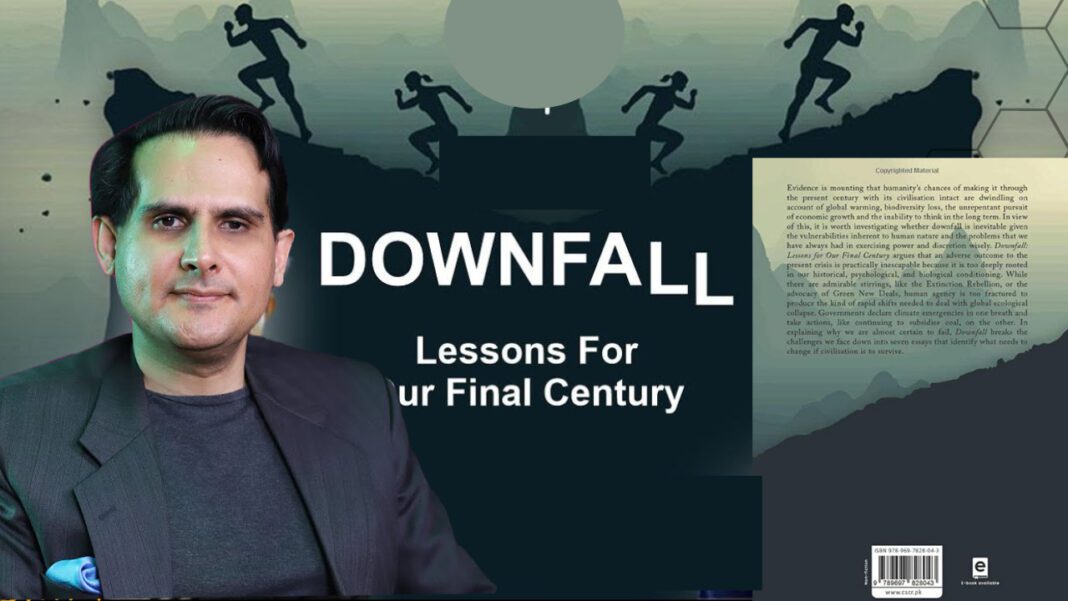Introduction
Downfall, Lessons for Our Final Century Ilhan Niaz CSCR, 2022 128 pages. The book, Downfall; Lessons for Our Final Century is written by Dr. Ilhan Niaz who is a Professor in the department of History at Quaid I Azam Unisversity, Islamabad.
Historical background
The book in actual fact is a collection of the author’s written essays. Amidst the Covid-19 crises, that hit the world very harshly, the author embarked upon publishing this book, considering the disease as a wakeup call from nature that something is seriously wrong with the human doings that need to be corrected and if not paid heed to, humans as a species will suffer a lot till the end of this century.
Downfall primarily drives attention to the problem of human’s inability to think rationally in the long run, as a result of which we are heading towards our collapse by the end of this century. The book can be divided into two main parts.
The first part deals with the historical background that provides reasons for where we stand today, while the second part deals with economics and alternatives for future as a way out. The historical accounts also explains the inability of humans to think wisely with respect to their future
Ibn e Khaldun
The author starts with ibn e Khaldun, a philosopher of human history. For Khaldun, the environment in which human beings live and the human psychology have greater influence over human’s minds, as a result of which they are always wrong in long term thinking and which is why the proneness to decline in future increases. Khaldun’s philosophy is important to understand the short-sightedness of human beings which serves the bases for their habit of short term gains.
Thomas Malthus and John Stuart Mill
The author then diverts the reader’s attention towards the predictions of two important philosophers of the past, Thomas Malthus and John Stuart Mill, highlighting current world’s problems regarding economics, growth and GDP. He starts with Malthusian constraints about the final outcome of growth, in this case the certain point of earth beyond which it would not sustain more growth.
This is then followed by the outcome predicted by John Stuart Mill as a result of continued growth, which is the replacement of growth oriented stage by a stationary phase and the equal redistribution of resources. Mill suggests that the redistribution of resources will lead to ultimate human happiness.
Darwin
The next personality that the author focuses on is Darwin. According to Darwin, humans are not invincible and as 99 percent of life on earth has been replaced by another life, same will be the fate of human beings. It can be said that if humans, who have evolved in their environment, tries to bring disturbances to that, they are not going to survive in the changed environment.
The idea that the author wants to emphasize on is that it is actually possible for us to predict the future outcomes from different historical patterns predicted by various philosophers, thinkers, and scientists and most probably we are heading towards that by the end of this century.
Economics and Alternatives for the Future
The second part of the book deals with the present day problem of infinite growth. An Infinite growth on a finite world always sounds absurd but this is what the fact is as far as human actions are concerned. In the past, different thinkers had agreed on one single point that is growth, though all having their own understandings about the final outcome.
So today if they are Marxists or Classical economists or even environmental economists, all of them have a single common aim of growth and, as mentioned above, the problem with the growth is that there is a fixed capacity of earth and beyond that it cannot sustain human needs inordinately.
The author is of the view that the dominant factor that leads to the idea of infinite growth is the problem of optimism. In this regard the author gives a very interesting example from Candide, a novel of Voltaire, where candid is a young man who constantly suffers but he is always reminded by Professor Pangloss that they are living in the best possible world of all times, giving him a sense of optimism. This is the problem from which the world suffers today in a way that the top 1 percent of population, that receives most of the GDP, gives this idea of false optimism that growth is good and in future, somehow, we would be able to come up with certain solutions to deal with the apocalyptic situation predicted by the people in the past, reference our technological and scientific development.
Solutions
In the end the author provides several solutions in the conclusive part of the book. So for example the author talks about the importance of thinking in historical terms, limitation of growth oriented intentions, pessimism in place of constant optimism, paying heeds to what the wise people suggests, including philosophers, academia and scientists and a need for a common global solution to deal with the alarming situation that we are about to suffer very shortly.
The Interaction of Solon of Athens and Croesus of Lydia
There is a very interesting small digression in the book that makes the book highly unique and highly interesting. The interaction of Solon of Athens and Croesus of Lydia is a must-read part of the book with respect to one’s interest in history.
Conclusion
The bottom-line is that the book is highly interesting and very important for anyone belonging to the specie of Homo sapiens because it has addressed the question of their survival to the next century. The alternatives provided by the author is the need of an hour and we can definitely survive as a specie to the next century, provided that those mentioned alternatives are somehow implemented.
The Author is an undergraduate student at the department of History, Quaid i Azam University, Islamabad.






